Menu
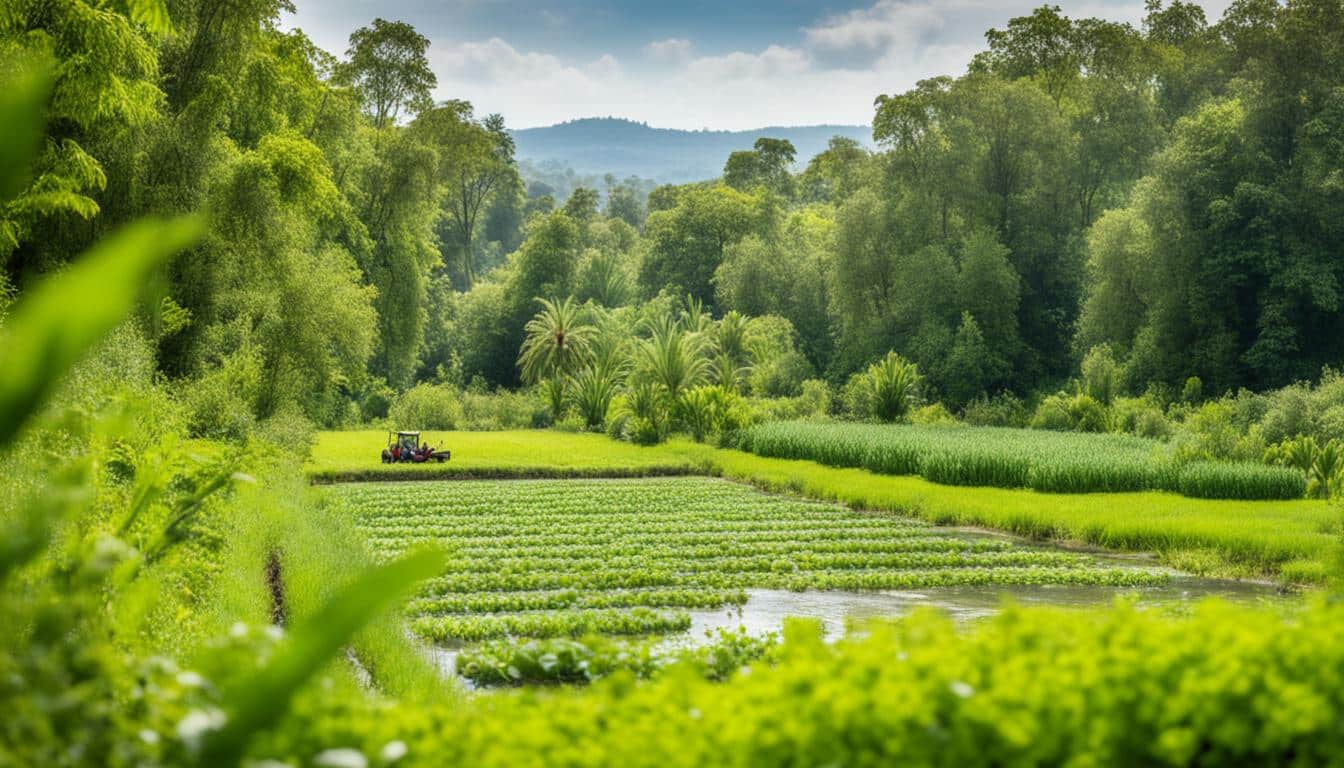
Did you know that on Earth, there might be over 8.7 million types of living things? This wide range of life is key to keeping our ecosystems and farms strong. For example, in the United States, grasslands covered 170 million acres. They housed plants and animals almost as much as the rainforests do.
The great diversity of life aids nature and our farming. Crops and animals have many different genes; this helps keep our food secure from diseases and changes. Sadly, large-scale farming often focuses on making things the same for easier production. This can harm the variety of plants and animals, both wild and home-grown.
On the other hand, farming that works with nature – sustainable farming – welcomes a mix of plants and animals. This friendly-to-nature farming helps protect the environment better. It also makes sure farms can keep going well for the people who come after us.
Biodiversity makes each spot on Earth special. It is the key for life to thrive, helping species cope with changes. Early farmers played a big role by selecting plants and animals. They shaped a world full of food types suited to different areas.
Genetic variation in crops helps farming systems withstand challenges. This diversity means plants can resist pests, diseases, and the changing climate. It’s crucial for high agricultural production and secure food supplies. Without it, agriculture would be at risk of significant damage.
Biodiversity is vital for maintaining healthy farming areas. It enables pollination and natural pest control. For instance, adding wild plants to fields can reduce insect harm on crops. This leads to better soil, more pollinators, and less need for chemical pesticides.
All of these benefits also touch human health and the economy. They underline how important diverse life is for farming success.
Industrial farming aims to grow as much food as possible. This goal affects many living things on our planet. For instance, large areas of forests and grasslands are changed into fields for crops. In just one year, the United States switched 2.5 million acres of grassland to farming land. This change makes it hard for different animals and plants to survive, lowering the variety of life on Earth.
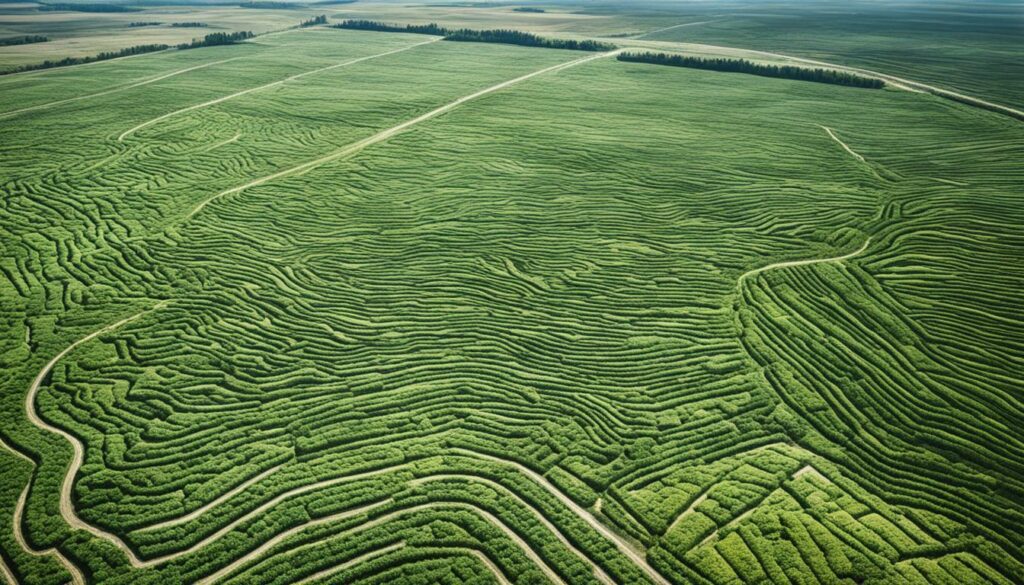
Most of the world’s deforestation is because of farming. Every year, areas as big as the United Kingdom of forests are cut down. These forests are vital for many animals and plants. Destroying them affects the natural balance on Earth, causing harm to species and their homes.
Modern farms use lots of chemicals like fertilisers and pesticides. One common chemical, glyphosate, harms wild plants around farms in the US. This decrease in plants affects creatures like the monarch butterfly, whose numbers are falling quickly. The chemicals used in farming can mess up the natural world nearby, making it hard for some animals to live there.
Growing just one type of crop in a large area, known as monoculture farming, also causes problems. It makes the farms more likely to get sick from pests and diseases. In the US, there has been a big push to grow plants for making fuel this way. This demand has led to large fields of just one kind of crop, like corn. But this move reduces the variety of food crops, making our food supplies less safe against changes in the environment.
| Impact | Statistics |
|---|---|
| Habitat Destruction | 2.5 million acres of grassland converted between 2015-2016 |
| Deforestation | Over 100,000 square miles of rainforest lost annually |
| Species Decline | 70% drop in monarch butterfly populations |
| Monoculture Spread | Millions of acres for monoculture crops like corn |
Summing up, industrial farming has a huge negative impact on the variety of life around us. It does this through destroying homes, spreading harmful chemicals, and growing only a few types of crops. We need to use ways of farming that protect the environment and keep our planet’s nature varied and healthy.
To fight the downsides of monocultures in farming, we need a mix of farming ways. Using crop rotation benefits, building agroforestry systems, and keeping heirloom seeds alive are key. They help nature a lot.
Crop rotation is great for the land and us. It means planting different crops in the same field at different times. This helps stop pests and makes the soil better. It makes the land’s structure stronger, helps good soil creatures, and shows how important crop rotation is.
Agroforestry systems mix trees with growing food and animals. This way, land is used well and nature benefits a lot. Trees stop the wind and keep the land from getting worn away. They also give homes to pollinators and other helpful creatures. Adding plants that grow back every year means there are homes for animals that help with pests and weeds. This keeps the land healthy in the long run.
Picking old seeds really helps keep nature’s variety. These seeds are strong in certain places and don’t get sick easily. Using old seeds not only helps nature but also makes our food more varied. This makes our food supply stronger over time.
| Technique | Benefit | Impact on Biodiversity |
|---|---|---|
| Crop Rotation | Improves soil health and reduces pest pressure | Promotes diverse soil organisms and disrupts pest life cycles |
| Agroforestry | Maximises land use and enhances ecological resilience | Provides habitats for pollinators and beneficial species |
| Heirloom Seeds | Preserves genetic diversity and enhances pest resistance | Conserves crop genetic diversity |
By using these farming techniques, we make our farms stronger and kinder to the Earth. They solve problems and help us for a long time.
Organic farming is very good at supporting more diverse wildlife. It does this by not using artificial fertilisers and pesticides. This helps create a rich and varied environment on the farm. It also makes the soil healthier and boosts the local ecosystem.
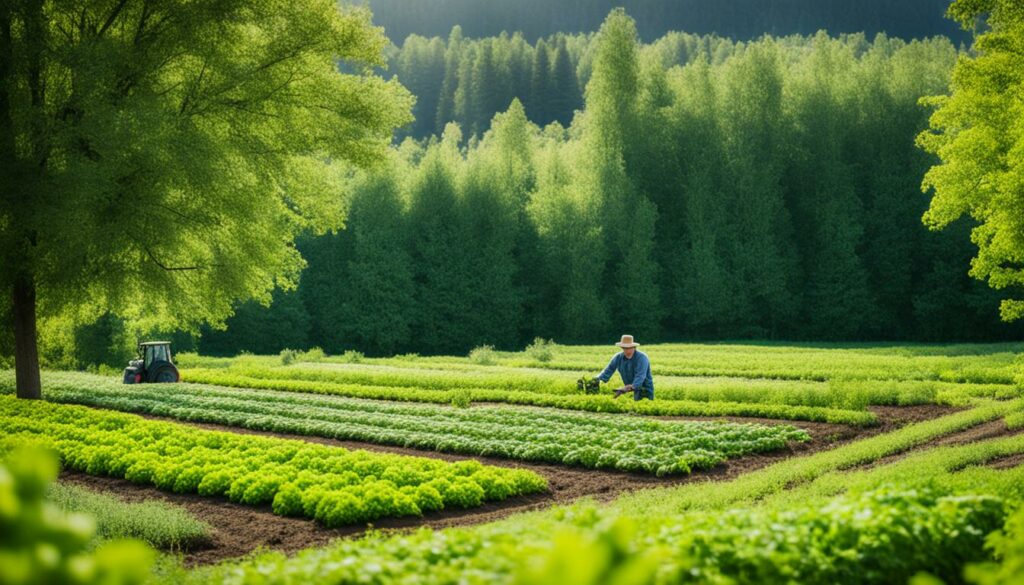
Organic farming focuses a lot on keeping the soil fertile. It uses methods like rotating crops and adding compost to the soil. These help keep the ground lively with good bacteria. They stay away from harmful chemicals that can harm the soil in the long run.
Organic farming is great for making the soil more alive. Research shows it can have a lot more types of plants (20-95% more) and bigger plant communities (up to 150% more). By not using dangerous chemicals, it can also keep more insects and pollinators around.
In 2018, the EU showed it really values these benefits. They gave over 1.8 billion € to support organic farming. This has helped grow more biodiversity on 8% of the EU’s land. It follows a big goal to increase biodiversity by 30% through organic farming.
It’s clear that organic farming isn’t just about making soil better. It’s key to looking after our plant and animal friends too. By farming in a natural way, we can make sure our countryside thrives. This is very important for a healthy future in farming.
Agroecology boosts the strength and sustainability of our food systems. It takes lessons from nature to encourage varied and steady diets. This can help lessen rural poverty and make life better for people. By using methods that renew the land, it lifts incomes for family farmers. It also cuts their need for outside help, keeping market prices steady.
The good things about agroecology touch many parts of farming. It makes use of nature to make farming better without harming it. This approach grows food in ways that are good for the earth and the people who eat the food. It makes the land stronger, grows more food, and helps with things like keeping away pests.
Agroecology also helps make good jobs for young people in farming that cares for the earth. Women are key in this, helping with things like growing different foods and saving the land. This also fights against unfair treatment of women. Agroecology stands up for everyone’s right to use resources fairly and to have a say in how things are done.
This way of farming is known worldwide for its power to make farming strong and protect nature. It fits everywhere, from small farms to big companies. By making sure there’s a lot of different life in an area, it helps the whole area be strong. This means it’s good at stopping pests and making sure nutrients are used well, key things for making food the right way.
Agroecology wants to use fewer chemicals, like fake bug killers and plant food. This way of farming doesn’t hurt the earth. It also makes farming cheaper, both for people’s pockets and for the earth. This keeps things fair and helps economies grow locally.
The table below summarises key points of agroecology’s contribution to sustainable food systems:
| Principles | Benefits |
|---|---|
| Promotes Diversity | Enhances ecosystem resilience, pest control, and nutrient cycling |
| Improves Soil Health | Boosts productivity, sustainable livelihoods |
| Reduces Chemical Inputs | Minimises environmental impacts |
| Inclusivity and Equity | Empowers local leaders, reduces production costs |
Overall, agroecology makes farming live in harmony with nature. It aims to keep our food systems strong and good for our children and their children.
It’s important to use farming methods that help wildlife. This is vital for keeping a good balance in nature and helping many different plants and animals to live. These farming methods create good homes for animals on the farm. They also help control bad bugs naturally and protect crops from bad weather.
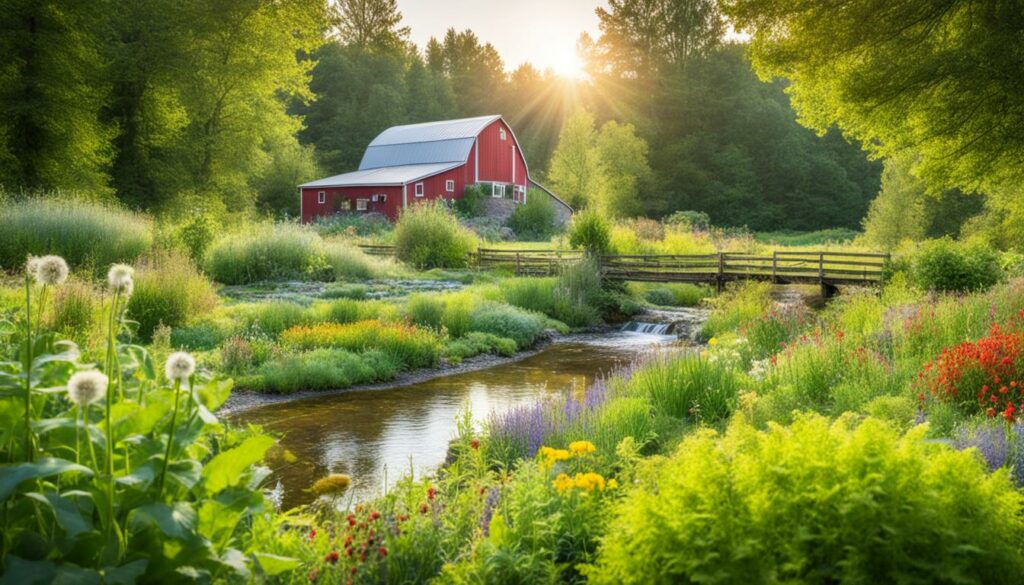
Farms can be great homes for all kinds of animals. By adding beetle banks, birdhouses, and ponds, farms become places where wildlife can flourish. A study found that farms focused on biodiversity and conservation had a 25% increase in habitat diversity. They had more diverse life at 100 metres than other farms without these practices. Organic farms also did well, attracting more butterflies and plant species than the rest through smart habitat planning.
This shows how creating specific wildlife habitats on farms can make a big difference. It attracts more animals and plants, making the farm a richer and healthier place.
Looking after hedgerows is another important farming method for wildlife. Good hedgerows help animals move around and keep a strong and mixed nature. They connect different areas, making sure animals can find new mates and keep their populations strong. Well-kept hedgerows increase the types of places animals like to live by 20% over ordinary farms. This leads to more diverse habitats and a healthier mix of species. Even though not much difference was seen in bee and bird counts between different farms, the landscape made by careful farming improves the overall environment.
Mixing different wildlife-friendly methods is best for farms. Using organic or conservation methods together with special habitats and hedgerows supports a lot more life. Three out of four farms that help wildlife this way also take part in a special conservation scheme. This all helps make farming more successful in the long run.
| Farming Scheme | Habitat Diversity at 100-m Scale | Habitat Diversity at 250-m Scale | Butterfly Species Richness | Plant Species Supported |
|---|---|---|---|---|
| CG Farms | 25% Higher | 20% Higher | 50% Higher | 70% More |
| Organic Farms | 25% Higher | 20% Higher | 50% Higher | 70% More |
| ELS Farms | Baseline | Baseline | Baseline | Baseline |
Regenerative farming boosts our environment in many ways. It helps the soil regenerate, captures carbon, and brings back more plants and animals. If we raise the soil’s organic matter by just 0.1%, we can trap almost nine tonnes of CO2 a year. This makes it key in fighting climate change.
These techniques keep the soil healthy by not disturbing it much. They add cover crops and compost. They also change what crops are grown and how animals are used on the farm. This all helps the soil and crops to be full of good nutrients and minerals.
On top of that, farms using these methods grow lots of different plants, from corn to nuts. Having such variety can increase how much food is grown by 15 to 35%. This shows us the real gains from diversity.
At first, it might cost more to switch to these methods. But, over time, there are savings because you use fewer chemicals and water. Plus, the farm becomes more productive and the plants tougher. So, it makes money sense too.
Also, more people want food that is grown in smart ways. They’re willing to pay more for it. Regenerative farming is good for the earth and for business. It helps bring back different plants and animals too.
One of the most exciting things is how much the soil can change for the better. It could take in more carbon than we even put out each year from burning fossil fuels. This shows us that looking after the soil well could help a lot to stop climate change.
| Benefits | Regenerative Farming Practices |
|---|---|
| Soil Regeneration | Minimising soil disturbance, cover crops, compost, crop rotations, livestock integration |
| Carbon Sequestration | Increases soil organic matter, captures CO2 |
| Biodiversity Restoration | Cultivates diverse plant species, improves soil biodiversity |
| Nutritional Profile | Healthier crops with higher mineral and vitamin content |
In biodiverse farming, soil health is key. The ground is full of life that supports strong farming techniques. It’s important to protect and improve the soil’s diverse life for the future of farming.
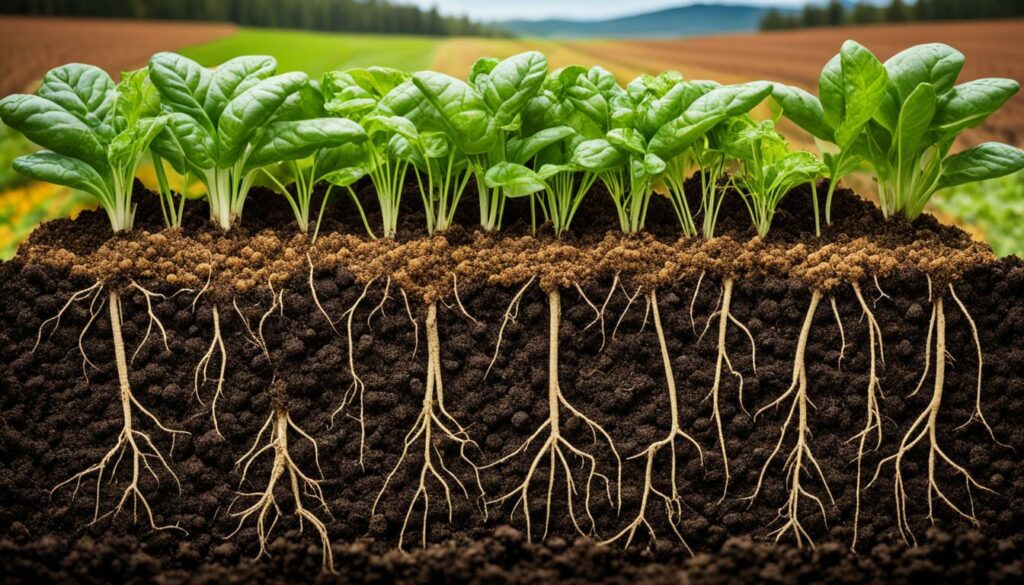
Soil biodiversity means many small and big creatures in the soil. A teaspoon of good soil has about 6 billion tiny organisms. This rich life in the soil helps plants grow, fights off bad chemicals, and provides nutrients. Healthy soil is vital for a good farm and a rich planet, making it important to take care of the soil’s diverse life.
We can make soil healthier with smart farming ways. For example, using less plowing and growing plants to cover the soil helps a lot. Also, farming without artificial chemicals but with natural fertilisers boosts the soil’s life.
The FAO says soil biodiversity is worth more than US$1542 billion. This shows the true value of healthy soil for the planet and our prosperity. Yet, it’s very easy to harm the soil, which means we must protect it urgently. Everyone around the world should care more about soil health.
Conservation agriculture is vital for protecting agro-biodiversity. About one-third of the world’s lands are used for growing crops. They cover 30% of the Earth’s surface. So, we need smart plans to look after our land.
Another 10-20% of the land is used for grazing animals. This means 80-90% of all lands where life thrives sees human impacts. That’s why using land well is key for nature’s balance. Combining farming with protecting nature helps us avoid losing more habitats.
Turning forests into farmland harms wildlife and affects our climate. Shockingly, even protected areas are heavily farmed. This shows we must wisely farm to protect our wild spaces.
Dealing with the impact of raising livestock is also crucial. As people worldwide want more meat, we have to find ways to farm that don’t harm our planet.
Encouraging native plants and animals is a big part of saving biodiversity. By designing farms to give species a home, farmers can help save Earth’s variety of life. Every farmer who protects nature helps save our shared natural world.
Biodiversity is crucial for not just the environment but also for boosting farm finances. It does this by adding different plant and animal types, leading to better harvests. This mix helps to keep farms strong and sales steady.
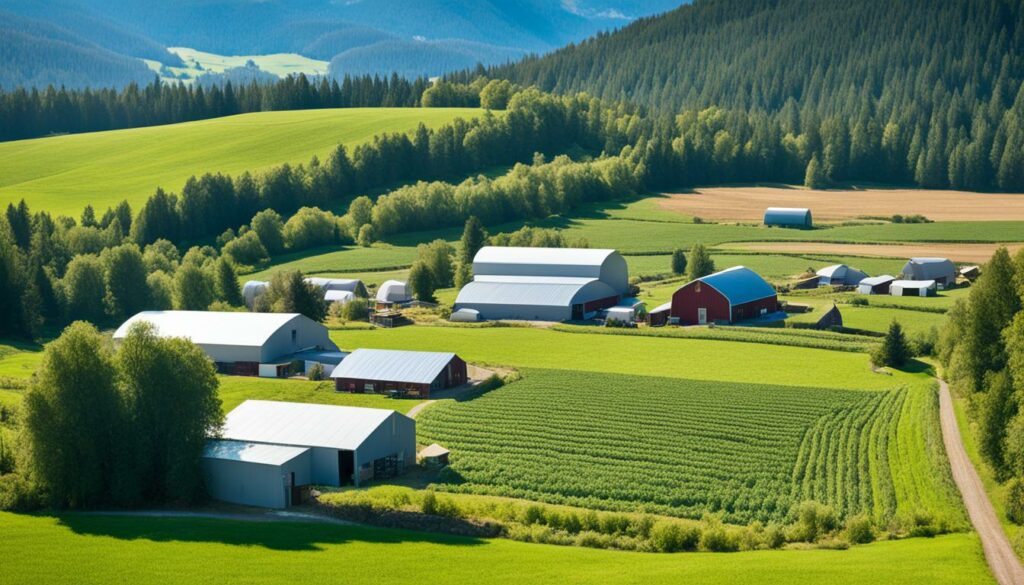
Growing several types of crops and raising different animals helps a lot. It makes a farm better able to deal with problems like pests or bad weather. That makes the farm more productive and stable. This leads to more to sell and less need for things like pesticides.
Having a varied farm also cuts down on how much the market’s ups and downs can hurt. This is really good in places where prices often change a lot. A mixed farm can more easily shift to what buyers want. This keeps the money coming in even when the market changes.
Keeping a variety of plants and animals on farms is more important than ever. It helps the planet and the economy. By using these diverse methods, we keep farming strong and healthy. This supports both our economy and the environment.
Agro-biodiversity case studies show many successful farming and agriculture examples around the world. These examples prove that using diverse plant and animal life helps farms thrive. They also show how to combine different types of life on a farm.
In Ethiopia, the Soddo Forestry Project restored 503 hectares of forests, preventing erosion. In Kenya, the Hifadhi-Livelihoods Project planted a million trees. This project cuts 174,000 tons of CO2 every year.
In Ghana, the Ghana Cocoa Forest Redd+ Programme increased cocoa farming yields. This success comes from using better farming practices. The Kitalu Tree Planting Project in the same country fights deforestation. It does this by teaching farmers and planting trees.
In Japan, reforestation on Miyajima Island helped save the rare Miyajima salamanders. In New Zealand, the Kakapo Recovery Program has boosted Kakapo parrot numbers. Both examples highlight the power of careful conservation work.
The Gewocha Forest Project in Ethiopia improved forest health by planting over 12 million trees. The forests now support better agriculture and more wildlife. In Australia, the Great Barrier Reef Marine Park works hard to protect its ocean life. Despite problems like climate change and pollution, it still thrives.
In the Philippines, local people manage a marine area in Palawan. This area helps save marine life and offers jobs to the community. In Costa Rica, the Turning 25 Hectares Project plans to plant many different plants. This effort will make the area’s nature stronger.
All these success stories underline the benefits of farming with many types of plants and animals. They show how farming this way can be good for nature and for farmers. From Africa to Asia and more, these examples are guiding lights for modern, successful farming.
Modern agricultural tech is changing how we help biodiversity. I am especially excited about precision farming and drone use for checking on biodiversity. They can make managing farms much better.
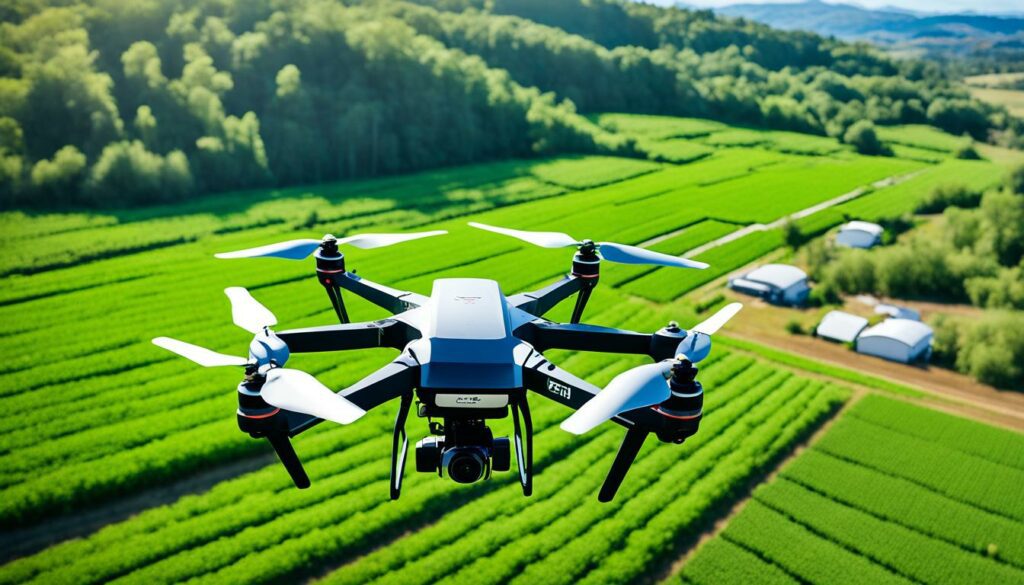
Sensors and analytics help farmers use their resources well. They boost crop production and cut down on harmful stuff like water waste and too many chemicals. This careful management is good for the soil and wildlife, making farming more nature-friendly.
Drones are a game-changer for watching over nature. They take great pictures from above and show what’s happening in real time. This helps us learn more about wildlife and their homes. It’s key for planning how to look after our environment better.
| Startup | Year Founded | Funding Amount | Focus Area |
|---|---|---|---|
| Restor | 2021 | $3.5 million | Environmental Services |
| Single.Earth | 2019 | $7.9 million | Carbon Credits |
| Forestbase | 2021 | Undisclosed | Forests as Assets |
| Pivotal | 2022 | £4.5 million | Data Infrastructure and Analytics |
| Spoor | 2020 | $12-18 million | Wildlife Monitoring |
| MORFO | 2022 | £4.2 million | Drone-based Reforestation |
Using these new technologies helps farms work better and be kinder to nature. Precision farming and drones for checking biodiversity are great examples. They show how we are moving towards doing farming that helps nature, not harms it.
As farming changes, making the right agricultural policy and regulatory frameworks matter a lot. They help keep nature safe while supporting farmers to work in sustainable ways. Many global and local plans are in place to protect the environment and encourage eco-friendly farming.
Worldwide, groups have set up global biodiversity agreements to save nature in farming. The Convention on Biological Diversity (CBD) is one big agreement. It shows how crucial it is to blend nature’s needs into how we grow food. This makes our farming more adaptable and healthy.’
In each country, they need to follow these big world goals in their own ways. This means making national strategy for sustainable farming based on the global rules. Governments are key in making clear plans that help farmers use these eco-good methods. In Africa, there’s a big push to add more long-term crops alongside the usual ones. This special move helps nature and makes farming last longer.’
Good regulatory frameworks mix making good farm products with caring for the environment. Take California as an example. Agricultural work there has all but destroyed 91% of the wetlands. This shows the hard impact on our local lands. So, countries must tackle these problems by encouraging good farming that cares for our planet. They can do this by offering rewards for looking after nature while growing food.
| Region | Biodiversity Initiative | Impact |
|---|---|---|
| Global | Convention on Biological Diversity (CBD) | Guides international efforts to integrate biodiversity in agriculture |
| Africa | National Strategy for Sustainable Farming | Encourages the diversification of crops to improve ecosystem resilience |
| California | Wetland Conservation Programmes | Addresses the significant loss of wetlands due to agricultural practices |
The effort to protect our farms and our planet needs all governments to work together. With smart policies and rules everywhere, we can ensure that farming is both good for us and our earth.’
Community engagement plays a crucial role in improving biodiversity on farms. In the last fifty years, involving local people in conservation efforts has grown. This approach helps keep our natural world safe and healthy. Farmers and local communities working together create methods that are good for the Earth.
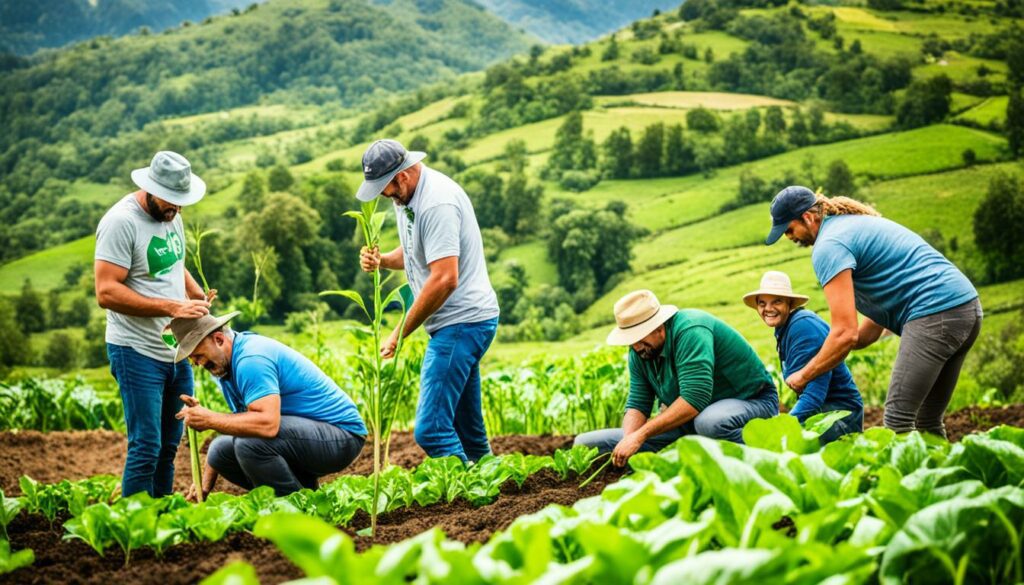
Think about East Africa’s famous places like Tsavo and Amboseli in Kenya, and Queen Elizabeth in Uganda. These parks show us how important it is to work together for nature. They used to be places where people lived, but now they’re shining examples of how communities can directly help the environment. Throughout the world, more and more space is being set aside for nature’s protection. This shows how key biodiversity is even beyond these special areas.
Different steps are taken to get communities involved in helping nature. Participatory farming initiatives are one key way. They not only protect nature but also help locals economically. Scientists and communities team up to look after nature well. This way, the benefits go beyond the land and reach the people too.
In local farming, leaders like Wendy Gady in Hawaii show the power of community work. Their projects, built and run by the local people, show us that with the right education, change is possible. People learn how to farm in an eco-friendly way. This empowers communities and makes them leaders in caring for the Earth.
The results speak for themselves. Boosting the local economy through community work is a major plus. It turns out community-led conservation can save money and people’s rights. When locals are in charge of protecting nature, it often works out well.
| Community Engagement Aspects | Benefits |
|---|---|
| Educational Programs and Workshops | Equip community members with essential farming knowledge |
| Community-Led Markets | Serve as platforms for engagement and economic benefits |
| Public-Private Partnerships | Foster sustainable agriculture through collaboration |
| Research and Development Projects | Involve community in innovative agricultural solutions |
Working together strengthens our food systems and shows how flexible these projects are. For example, Integrated Conservation and Development Programs (ICDPs) really help both people and nature. Together, we make sure farming helps the Earth without hurting local traditions. This leads to everyone living in balance with nature.
Introducing biodiversity in farming faces many challenges. Despite its great importance, adopting diverse farming systems is not easy. We will explore some major difficulties.
Money issues stop farmers from going biodiverse. Upgrading to biodiverse methods needs a lot of cash upfront. This includes new equipment, seeds, and training. All these are extra costs.
But the problems don’t end there. Markets are mainly set up for simple, single-crop farming. So, it’s hard for farmers to sell varied crops well. This makes it less tempting to try diverse farming, keeping big farms in the lead.
Global movement of turning wild lands into farms reflects these challenges. In a single year, over 2.5 million acres became cropland in the US. This shows the strong impact of money on farming choices.
Many farmers don’t know about the benefits of biodiversity. They struggle to use these methods correctly. This lack of knowledge can mean that efforts to promote biodiversity face pushback or are not used well.
Improving education is vital. Some groups have tried to increase knowledge about biodiversity, like the CGIAR in the 1970s. But, these efforts often lack enough money and support to make a lasting difference.
Changing long-held farming practices is hard. Many traditional farming communities resist new techniques. This is due to both cultural attachment and not understanding the benefits of biodiverse farming.
Overcoming the above challenges is crucial. It takes action from policymakers, markets, and schools to help farmers switch to more sustainable practices. Such shifts are necessary for a healthier environment.
Looking after biodiversity in farming is more than just a good idea; it’s essential for the future of our farmlands. The world is losing many species fast because of people. So, it’s vital that farming helps protect different types of plants and animals.
Fewer and fewer creatures like mammals, birds, and fish are around today. This shows we must farm in a way that helps nature thrive. This includes growing various plants, looking after the soil, and keeping the whole farm in balance to feed ourselves and look after the Earth.
In recent times, farms have focused on growing just a few types of crops. They used to grow thousands of different plants. We need to start planting a variety again to keep our farms healthy without relying on harmful chemicals.
Most of the world’s wetlands, which help soak up carbon, have disappeared. It’s so important we start farming in ways that heal the damage and keep essential lands like these safe. This protects our food sources and the land for the future.
The World Economic Forum warns us that losing biodiversity is a big risk. Nearly half of our money around the world depends on nature. Planting many different things and keeping nature safe is crucial for our lives and the world’s economy.
To make sure that farming is good for our children’s children, we must focus on having many different plants and animals. This keeps the land fertile and helps farming thrive. Plus, it makes sure we still have a beautiful, healthy world to live in.
The table below shows how the old ways of farming are changing to protect nature for the future:
| Aspect | Traditional Agricultural Changes | Need for Biodiversity |
|---|---|---|
| Species Cultivated | Decreased from 6000 to fewer than 200 | Diverse crop rotations and genetic resources |
| Wetland Impact | 85% destroyed or disappeared | Integration of wetland conservation |
| Global GDP Reliance | Significant risk from biodiversity loss | Stability through diverse ecosystems |
| Farming Practices | High pesticide and fertiliser use | Sustainable methods with reduced chemicals |
Planting a variety of crops and looking after nature is key to a strong and varied farming future. It’s the best way to ensure our land can keep giving us food and a healthy place to live for a long time.
In closing, we’ve seen the importance of sustainable farming and protecting nature. It’s clear that using green farming methods is vital for our farming future. These methods include taking care of the soil and planting different crops together.
Better soil means we can grow more food without harming the earth. It also helps fight climate change and make our water cleaner. Keeping the variety of life in nature helps our farms work well. This is by helping plants grow, controlling pests, and keeping our food diverse. Protecting different habitats and using fewer chemicals are ways farmers can help nature thrive.
But changing farming for the better needs everyone to work together. This includes farmers, people who make the rules, scientists, those who buy food, and the general public. Strong rules, money help, and more advice for farmers are needed to make big changes. Also, teaching people about good farming and encouraging them to buy food that’s good for the planet can make a big difference. With learning and working together, we can make farming better for the earth and for our children.
Biodiversity is crucial in farming. It helps with essential tasks like pollination. Diverse systems are better at handling diseases and changes. In the end, they support farming that lasts long.
Industrial farming hurts biodiversity. It makes big areas of just one crop, losing natural homes. It also pollutes more, making a habitat where fewer plants and animals thrive.
To increase biodiversity, try rotating crops and mixing plants. Planting trees amongst crops is also helpful. Using traditional seeds can support a larger variety of life too.
Organic farming helps life by not using artificial chemicals. Instead, it uses things that help the soil and the creatures in it. Tilling the ground less and covering it can also do great things for nature.
Agroecology is about learning from nature to farm better. It focuses on field health and variety to make food without harming the land. By working with the environment, this approach keeps farming sustainable.
They can make spaces like beetle banks and bird houses. Adding ponds and keeping wild borders around fields helps too. These all bring more animals and plants to the area.
Regenerative methods, like lower tillage and adding compost, are good for the soil. They also help store water and capture carbon. All this aids many more living things to thrive.
Soil health is the basis for a good farm. A lively soil helps with food circulation, keeps pests in check, and grows well. It is key for a successful farmed area.
Efforts include keeping the native plants and animals near farms. Protecting them and copying natural areas are important. These steps help the whole ecosystem to stay varied and strong.
More types of plants and animals together in a farm can do more than just one alone. This boosts income and guards against changing markets. It helps farms to last and do well financially over time.
Many examples show how mixing plants boosts farming. It leads to more food, healthier soil, and a richer environment. These examples prove how valuable biodiversity is.
Tools like precision farming help farmers use resources better. Drones also keep an eye on the land’s health. These technologies are key to keeping farms diverse and productive.
Rules push farming to protect nature and diversity. Both global and local laws aim to mix farming with protecting the land. They set the stage for a balanced, sustainable farm future.
By getting everyone involved, communities help protect the land and its life. Together, people learn and support each other to farm wisely. This means both the land and people can thrive.
Farmers may struggle with costs and not knowing how much they can make. They also might not have the latest knowledge. To help, they need backing from many parts of society.
Teaching and celebrating good farming practices is one way. Making sure the land is rich and stable for the future is also crucial. This keeps farming alive and well for those ahead.